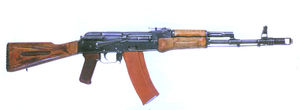AK-74
| AK-74 | |
|---|---|
 AK-74 |
|
| Type | Assault rifle |
| Place of origin | |
| Service history | |
| In service | 1974–present [1] |
| Used by | See Users |
| Wars | Soviet-Afghan War, various other conflicts in Asia and the Middle East |
| Production history | |
| Designer | Mikhail Kalashnikov |
| Designed | 1974 |
| Manufacturer | Izhevsk Mechanical Works |
| Produced | 1974–present |
| Number built | 5 million+[2] |
| Variants | AKS-74, AKS-74U, AKS-74UB, AK-74M, AK-101, AK-102, AK-103, AK-104, AK-105 |
| Specifications | |
| Weight | AK-74: 3.03 kg (6.7 lb) AKS-74: 2.97 kg (6.5 lb) AKS-74U: 2.5 kg (5.5 lb) AK-74M: 3.4 kg (7.5 lb) |
| Length | AK-74: 943 mm (37.1 in) AKS-74 (stock extended): 943 mm (37.1 in) AKS-74 (stock folded): 690 mm (27.2 in) AKS-74U (stock extended): 735 mm (28.9 in) AKS-74U (stock folded): 490 mm (19.3 in) AK-74M (stock extended): 943 mm (37.1 in) AK-74M (stock folded): 700 mm (27.6 in) |
| Barrel length | AK-74, AKS-74, AK-74M: 415 mm (16.3 in) AKS-74U: 210 mm (8.3 in) |
|
|
|
| Cartridge | 5.45x39mm |
| Action | Gas-operated, rotating bolt |
| Rate of fire | 650 rounds/min (AK-74, AKS-74, AK-74M) 650-735 rounds/min (AKS-74U) |
| Muzzle velocity | 900 m/s (2,953 ft/s) (AK-74, AKS-74, AK-74M) 735 m/s (2,411.4 ft/s) (AKS-74U) |
| Effective range | 600 m, 100–1,000 m sight adjustments 350–500 m sight adjustments (AKS-74U) |
| Feed system | 30-round or 45-round RPK-74 detachable box magazine |
| Sights | Adjustable iron sights, front post and rear notch on a scaled tangent Flip-up sight and front cylindrical post (AKS-74U) |
The AK-74 (Russian: Автомат Калашникова образца 1974 года or "Kalashnikov automatic rifle model 1974") is a 5.45mm assault rifle developed in the early 1970s in the Soviet Union. It was developed from the earlier AKM (itself a refined version of the AK-47) and introduced in 1974.
The rifle first saw service with Soviet forces engaged in the Afghanistan conflict.[3] Presently, the rifle continues to be used by the majority of countries of the former USSR. Additionally, unlicensed copies were produced in Bulgaria (AK-74 and AKS-74U), China (Type 88), the former East Germany (MPi-AK-74N, MPi-AKS-74N, MPi-AKS-74NK) and Romania (PA md. 86).[3][4][5]
Contents |
Design details
The AK-74 is an adaptation of the 7.62mm AKM assault rifle and features several important design improvements.[3] These modifications were primarily the result of converting the rifle to the intermediate-caliber 5.45x39mm cartridge, in fact, some early models are reported to have been converted AKMs, with the barrel re-sleeved to 5.45x39mm.[6] The result is a more accurate and reliable rifle than the AKM.[3] The AK-74 and AKM share an approximate 50% parts commonality (interchangeable are most often pins, springs and screws).
Operating mechanism
The rifle’s operation during firing and reloading is identical to that of the AKM.[7] After ignition of the cartridge primer and propellant, rapidly expanding exhaust gases are diverted into the gas cylinder above the barrel through a vent near the muzzle. The build-up of gases inside the gas cylinder drives the long-stroke piston and bolt carrier rearward and a cam guide machined into the underside of the bolt carrier rotates the bolt approximately 35° and unlocks it from the barrel extension via a camming pin on the bolt. The moving assembly has about 5.5 mm (0.2 in) of free travel which creates a delay between the initial recoil impulse of the piston and the bolt unlocking sequence, allowing gas pressures to drop to a safe level before the seal between the chamber and the bolt is broken. Like previous Kalashnikov-pattern rifles, the AK-74 does not have a gas valve; excess gases are ventilated through a series of radial ports in the gas cylinder. Since the Kalashnikov operating system offers no primary extraction upon bolt rotation, the AK-74 bolt has a larger extractor claw than the 7.62mm AKM for increased extraction reliability.[8] Other minor modifications were made to the bolt and carrier assembly.
Barrel
The rifle received a new barrel with a chrome-lined bore and 4 right-hand grooves at a 200 mm (1:8 in) rifling twist rate. The front sight base and gas block were redesigned. The gas block contains a gas channel that is installed at a 90° angle in relation to the bore axis. A pair of support brackets are cast into the gas block assembly and are used to attach a BG-15 or GP-25 under-slung 40 mm grenade launcher. The forward section of the front sight base features a threaded collar that is used to screw in a newly-designed multifunction muzzle device (performing the role of a muzzle brake, recoil compensator and flash suppressor) or a blank-firing adaptor. The muzzle device is held in place by a spring-loaded button and is quickly detachable. The distinctive muzzle brake features a large expansion chamber, two symmetrical vertical cuts at the forward end of the brake and three vent holes positioned to prevent muzzle climb and lateral shift to the right (for right-handed shooters). A flat plate near the end of the brake produces a forward thrust when emerging exhaust gases strike its surface, eliminating nearly all felt recoil. The muzzle brake prevents backblast from reaching the firer, although it is reported to be harsh on bystanders as the muzzle gases are dispersed to the sides.[9]

New features
The AK-74 was equipped with a new stock, handguard (which retained the AKM-type finger swells) and gas cylinder. The stock has a different shoulder pad than the AKM, which is rubber and serrated for increased traction. In addition, there are weight-reducing lightening cuts on each side of the buttstock. These also function to distinguish externally by sight and touch between the AKM and the AK-74, preventing the accidental loading of the wrong ammunition in the AK-74. The stock, lower handguard and upper heatguard were first manufactured from laminated wood, this later changed to a synthetic plum and then a black-colored polymer.
The AK-74 gas tube has a spring washer attached to its rear end designed to retain the gas tube more securely. The lower handguard is fitted with a leaf spring that reduces play in the rifle's lateral axis by keeping the wood tensioned between the receiver and the handguard retainer. The receiver remains nearly identical to that of the AKM; it is a 1 mm (0.04 in) thick sheet steel pressing supported extensively by pins and rivets. The internal guide rails on which the bolt carrier travels are stamped and spot welded to the inside of the receiver housing. Minor changes were made to the front barrel and rear stock trunnions as well as the magazine well. All external metal surfaces are coated with a glossy black enamel.
Magazines
The original AK-74 magazine was identical to that of the AKM, except for minor dimensional changes required by the 5.45x39mm cartridge. These rust-colored magazines are often mistakenly identified as being made of Bakelite (a phenolic resin), where in reality, they were fabricated from a two-part glass-reinforced polyethylene plastic molding, assembled using an epoxy resin adhesive.[10] Noted for their durability, the magazines did however compromise the rifle's camouflage.[10] A new dark-brown (newer magazines are black) 30-round magazine was introduced in the early 1980s, composed of ABS plastic. All AK-74 magazines have a raised horizontal rib on each side of the rear lug to prevent their use in a 7.62x39mm AK. The magazines can be quickly recharged from stripper clips. The 45-round plastic magazine of the RPK-74 light machine gun is also interchangeable with that of the AK-74.
Accessories
Accessories supplied with the rifle include a 6H4 or 6H5 type bayonet, a quick-loading device, three spare magazines, four 15-round stripper clips, maintenance kit, cleaning rod and sling. The bayonet is installed by slipping the muzzle ring around the flash hider and latching the handle down on the bayonet lug under the front sight base. The rifle fires the intermediate 5.45x39mm M74 rifle ammunition that includes the jacketed, steel-core 7N6 bullet, 7T3 tracer round and a blank cartridge. The ammunition was developed by a team of designers led by Victor Sabelnikov.
Variants
AKS-74


The AKS-74 ("S" – Skladnoy [Folding]), is a variant of the AK-74 equipped with a side-folding metal shoulder stock, designed primarily for use with air assault infantry and developed alongside the basic AK-74. Unlike the AKMS's somewhat fragile underfolding stock (modeled after the MP 40 submachine gun stock), the AKS-74 stock is fabricated from stamped sheet metal struts, machine pressed into a "U" shape and assembled by punch fit and welding. The stock has a triangular shape; it lacks the folding shoulder pad found on the AKMS stock and is folded to the left side of the receiver. The hinged stock is securely locked in its extended position by a spring-loaded button catch located at the rear of the receiver, on the left side. When folded, the stock is held closed by a spring-loaded capture hook situated on the left side at the front of the receiver housing. A rear-mounted sling swivel is also provided on the right side at the beginning of the stock frame.
AKS-74U

In 1979, a shortened carbine variant of the AKS-74 was adopted into service with the Soviet Army: the AKS-74U (U—Ukorochenniy, lit. Shortened), which in terms of tactical deployment, bridges the gap between a submachine gun and an assault rifle. It was intended for use mainly with special forces, airborne infantry, rear-echelon support units and armored vehicle crews. It is still used in these roles, but has been augmented by various submachineguns, and the AK-105. It is also commonly used by law enforcement; for example, each urban police foot patrol is issued at least one.
The rifle's compact dimensions, compared to the AKS-74, were achieved by using a short 210 mm (8.3 in) barrel (this forced designers to simultaneously reduce the gas piston operating rod to an appropriate length). In order to effectively stabilize projectiles, the barrel’s twist rate was increased from 200 mm (1:8 in) to 160 mm (1:6.3 in). A new gas block was installed at the muzzle end of the barrel with a new conical flash hider combined with a cylindrical muzzle booster, which features an internal expansion chamber that increases the weapon's reliability. The booster enhances the recoil impulse by supplying the gas system with residual gases from the barrel. The chrome-lined muzzle booster also burns any remaining propellant thus reducing the gun's signature. The muzzle device locks into the gas block with a spring-loaded detent and features two notches cut into the flash hider cone, used for disassembly using the supplied cleaning rod. The forward sling loop was relocated to the left side of the carbine and the front sight was integrated into the gas block.
The AKS-74U also has a different sighting system with a U-shaped flip sight instead of the standard sliding notch rear sight. This sight has two settings: "P" (calibrated for firing at 350 m) and "4–5" (used for firing at distances between 400–500 m). The rear sight is housed in a semi-shrouded protective enclosure that is riveted to the receiver's top cover. This top cover is integral with the gas tube cover and hinged from the barrel trunnion, pivoting forward when opened. Both the gas tube and handguard are also of a new type and are shorter than the analogous parts in the AKS-74.
The AKS-74U is significantly more maneuverable in tight quarters than the AKS-74, however the significant decline in muzzle velocity from 900 m/s (2,952.8 ft/s) to 735 m/s (2,411.4 ft/s) resulted in a decrease in effective range (the effective hitting distance for a "running"-type silhouette target was reduced from 625 to 350 m). The carbine cannot mount a bayonet or standard under-barrel grenade launcher. However, a suppressed 30 mm BS-1 grenade launcher was developed specifically for that platform that fires a high-explosive dual purpose (HEDP) grenade. The grenades for the BS-1 are launched by blank cartridges and the rifle is cycled manually in this mode of operation. The majority of AKS-74U carbines were manufactured at the Tula Arms Factory rather than Izhmash. The AKS-74U was also used as the basis for several other unique weapons, including the bullpup OTs-14 Groza specialist carbine and the Gepard series of multi-caliber submachine guns (none of which evolved past prototype stage).
Specialized variants
The AK-74 is also available in several "night-fighting" configurations, equipped with a side-rail used to mount night vision sights (these variants, the AK-74N, AKS-74N and AKS-74UN are used in conjunction with NSPU and NSPUM sights). The AKS-74UB ("B"—Besshumniy) is a sound-suppressed variant of the AKS-74U adapted for use with the PBS-4 suppressor (used in combination with subsonic 5.45x39mm US ammunition).[11] Very little is known about this model.
AK-74M

In 1991 the Izhmash factory in the city of Izhevsk began full scale production of an improved variant of the AK-74 – the AK-74M (M – Russian: Модернизированный; Modernizirovanniy or "modernized") assault rifle. Apart from several minor production improvements the rifle also features a new synthetic stock made from a black, glass-filled polyamide that is shaped like the AK-74 fixed stock, but also folds like in the AKS-74S. Additionally the AK-74M uses a reinforced muzzle device and dust cover. Each AK-74M is fitted with a side-rail bracket for mounting optics. The AK-74M would have been adopted by the Soviet Union as the standard service rifle, and has been accepted as the new service rifle of the Russian Federation.
AK-100 series
The AK-74 was also the basis for the new Russian family of Kalashnikov firearms: the 5.56 mm AK-101 standard rifle and 5.56 mm AK-102 carbine (both use the NATO-standard 5.56x45mm cartridge), 7.62 mm AK-103 assault rifle and 7.62 mm AK-104 (both chambered for the 7.62x39mm M43 round) and the 5.45 mm AK-105 carbine (adapted to use 5.45x39mm M74 ammunition). The AK-101, 102, 103 and 104 are destined primarily for export, while the AK-105 is slated to replace the AKS-74U with the Russian Armed Forces. In 2010 a new variant, the AK-200 series, was unveiled. It differs in weight and has enhanced modularity.
Users


 Afghanistan[12]
Afghanistan[12] Armenia[12]
Armenia[12] Azerbaijan[12]
Azerbaijan[12] Belarus[12]
Belarus[12] Bulgaria[12] Bulgarian modification manufactured by Arsenal J.S.Co as the 7.62x39mm AR-M1 [13] [14]
Bulgaria[12] Bulgarian modification manufactured by Arsenal J.S.Co as the 7.62x39mm AR-M1 [13] [14] East Germany: Manufactured locally.[1]
East Germany: Manufactured locally.[1] Estonia[12]
Estonia[12] Georgia[12]
Georgia[12] Jordan[12]
Jordan[12] Kazakhstan[12]
Kazakhstan[12] Kyrgyzstan[12]
Kyrgyzstan[12] Moldova[12]
Moldova[12] Mongolia[12]
Mongolia[12] Poland: Manufactured locally.[1]
Poland: Manufactured locally.[1] Romania: Manufactured locally.[1]
Romania: Manufactured locally.[1] Russia: AK-74M is currently the main service rifle in the Russian Army.[1]
Russia: AK-74M is currently the main service rifle in the Russian Army.[1] Soviet Union: First used in battle in Afghanistan in the early 1980s.[15]
Soviet Union: First used in battle in Afghanistan in the early 1980s.[15] Tajikistan[12]
Tajikistan[12] Turkmenistan[12]
Turkmenistan[12] Ukraine[12]
Ukraine[12] Uzbekistan[12]
Uzbekistan[12]
References
- ↑ 1.0 1.1 1.2 1.3 1.4 http://world.guns.ru/assault/as02-e.htm
- ↑ militaryparitet.com (Russian)
- ↑ 3.0 3.1 3.2 3.3 Woźniak, Ryszard: Encyklopedia najnowszej broni palnej—tom 1 A-F, page 25. Bellona, 2001.
- ↑ Cutshaw, Charlie: The New World of Russian Small Arms & Ammo, page 92. Paladin Press, 1998.
- ↑ McNab, Chris: The AK47 (Weapons of War), page 25. Spellmount Publishers, 2001.
- ↑ Kokalis, Peter: Weapons Tests And Evaluations: The Best Of Soldier Of Fortune, page 45. Paladin Press, 2001.
- ↑ Woźniak, 26
- ↑ Kokalis, 46
- ↑ Hogg, Ian & Weeks, John. Military Small Arms of the 20th Century, 7th Edition Krause Publications. (2000) ISBN 0-87341-824-7.
- ↑ 10.0 10.1 Kokalis, 49
- ↑ Cutshaw, 19
- ↑ 12.00 12.01 12.02 12.03 12.04 12.05 12.06 12.07 12.08 12.09 12.10 12.11 12.12 12.13 12.14 12.15 Jones, Richard D. Jane's Infantry Weapons 2009/2010. Jane's Information Group; 35 edition (January 27, 2009). ISBN 978-0710628695.
- ↑ 5.56mm AR-M1 & AR-M1F
- ↑ 7.62mm AR-M1 & AR-M1F
- ↑ Marchington, James (2004). The Encyclopedia of Handheld Weapons. Lewis International, Inc. ISBN 1-930983-14-X.
References
- Cutshaw, Charlie (1998). The New World of Russian Small Arms & Ammo. Boulder, Colo.: Paladin Press. ISBN 0-87364-993-1.
- Kokalis, Peter (2001). Weapons Tests And Evaluations: The Best of Soldier of Fortune. Boulder, Colo.: Paladin Press. ISBN 978-1-58160-122-0.
- McNab, Chris (2001). The AK47 (Weapons of War). Staplehurst, UK: Spellmount Publishers. ISBN 978-1862271166.
- Walter, John (2006). Rifles of the World (3rd ed.). Iola, Wis.: Krause Publications. ISBN 9780896892415.
- (Polish) Woźniak, Ryszard (2001). Encyklopedia najnowszej broni palnej - tom 1 A-F. Warsaw, Poland: Bellona. pp. 25–29. ISBN 83-11-09149-8.
External links
|
|||||||||||